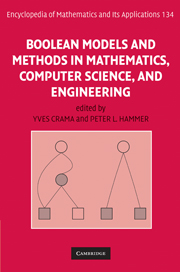Book contents
- Frontmatter
- Contents
- Preface
- Introduction
- Acknowledgments
- Contributors
- Acronyms and Abbreviations
- Boolean Models and Methods in Mathematics, Computer Science, and Engineering
- Part I Algebraic Structures
- Part II Logic
- Part III Learning Theory and Cryptography
- 6 Probabilistic Learning and Boolean Functions
- 7 Learning Boolean Functions with Queries
- 8 Boolean Functions for Cryptography and Error-Correcting Codes
- 9 Vectorial Boolean Functions for Cryptography
- Part IV Graph Representations and Efficient Computation Models
- Part IV Applications in Engineering
7 - Learning Boolean Functions with Queries
from Part III - Learning Theory and Cryptography
Published online by Cambridge University Press: 05 June 2013
- Frontmatter
- Contents
- Preface
- Introduction
- Acknowledgments
- Contributors
- Acronyms and Abbreviations
- Boolean Models and Methods in Mathematics, Computer Science, and Engineering
- Part I Algebraic Structures
- Part II Logic
- Part III Learning Theory and Cryptography
- 6 Probabilistic Learning and Boolean Functions
- 7 Learning Boolean Functions with Queries
- 8 Boolean Functions for Cryptography and Error-Correcting Codes
- 9 Vectorial Boolean Functions for Cryptography
- Part IV Graph Representations and Efficient Computation Models
- Part IV Applications in Engineering
Summary
Introduction
The objective of machine learning is to acquire knowledge from available information in an automated manner. As an example, one can think of obtaining rules for medical diagnosis, based on a database of patients with their test results and diagnoses. If we make the simplifying assumption that data are represented as binary vectors of a fixed length and the rule to be learned classifies these vectors into two classes, then the task is that of learning, or identifying a Boolean function. This simplifying assumption is realistic in some cases, and it provides a good intuition for more general learning problems in others.
The notion of learning is somewhat elusive, and there are a large number of approaches to defining precisely what is meant by learning. A probabilistic notion, PAC (probably approximately correct) learning, based on random sampling of examples of the function to be learned, is discussed by Anthony in Chapter 6 of this volume. Here we discuss a different approach called learning by queries, introduced by Angluin in the 1980s [5]. In this model, it is known in advance that the function to be learned belongs to some given class of functions, and the learner's objective is to identify this function exactly by asking questions, or queries, about it. The prespecified class is called the target class, or concept class, and the function to be learned is called the target function, the target concept, or simply the target.
- Type
- Chapter
- Information
- Publisher: Cambridge University PressPrint publication year: 2010
- 2
- Cited by

